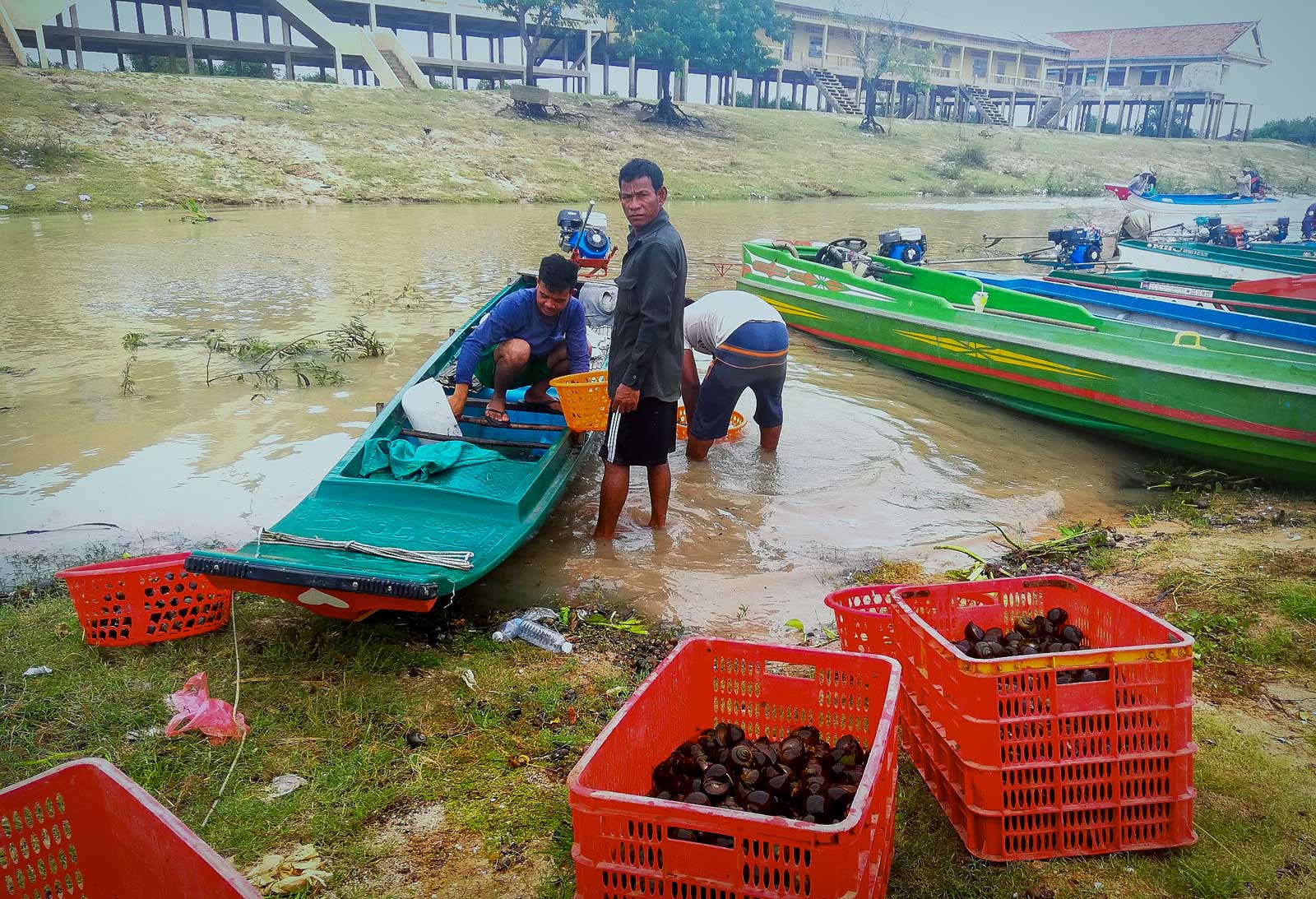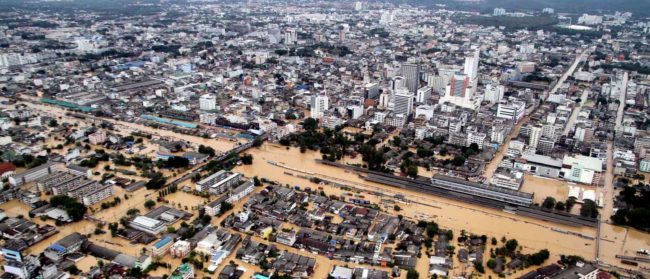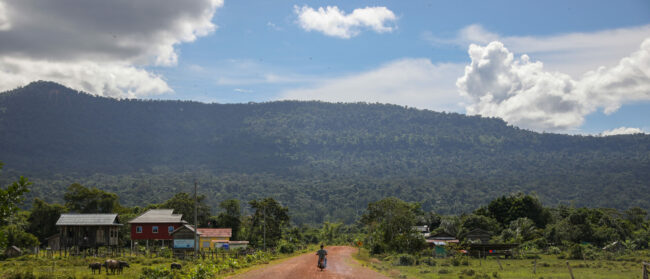Cambodia’s silent heartbeat is slowing. On the banks of Cambodia’s largest lake, fields that would normally be flooded with rich water lie fallow under the sun. Inches from the stagnant water, painted eyes stare from the prows of garish boats, their pilots sifting through baskets of snails. In years gone by, their nets would have been sagging with freshwater fish.
For the fishermen who ply their trade on Cambodia’s Tonle Sap, these are desperate times. And desperate times call for desperate measures.
“I have no choice, I decided to use machines to find fish even though I know it is illegal,” admitted Sothea as he sat on the wooden floor of his floating home. There are deep cracks between the floorboards, kept afloat by barrels and tyres. Some of the cracks are so wide you can see the dull glint of the water beneath.
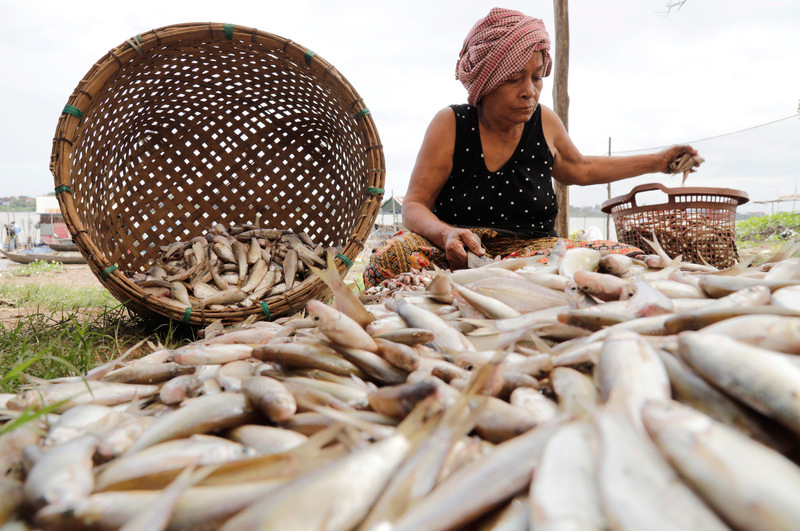
Sothea, whose name has been changed to protect his identity, is the sole breadwinner for his family. He can sell one kilo of snails for 3,500 riel, just shy of one dollar, but he can sell fish for far more.
“Snails can be found in the lake, but today I could find only two kilos of them,” he said. “I find it very hard to support my family.”
Illegal fishing methods such as stunning fish with electrical rods and nets with holes tight enough to snare even the smallest minnows are the only way to guarantee a catch these days – there are precious few left in the shrivelled lake, Sothea said. With a wife and four children to feed – and school fees to pay – a fine of $10-25 is worth the risk.
The family have lived for 15 years floating on the Tonle Sap lake, moored in Chnok Tru, a fishing community at the southernmost part of the lake where the river of the same name meets it in a bottleneck. The commune moves with the rise and fall of the waters, its inhabitants towing their houses and stores in to deeper water as the levels recede, and then back to the shallows once they rise.
Last August, Sothea said, he could earn up to $50 dollars every day catching fish and clams. Thida, his wife – again, not her real name – recalls the waters flooding the children’s classroom.
“This time last year the water level rose to the primary school floor,” she said.
In past Augusts, the Tonle Sap would be reaching full capacity, submerging roads and trees and lapping at the edges of the local school perched on three-metre-tall stilts.
“This year, the water level is so low, and the fish are so rare,” she said.
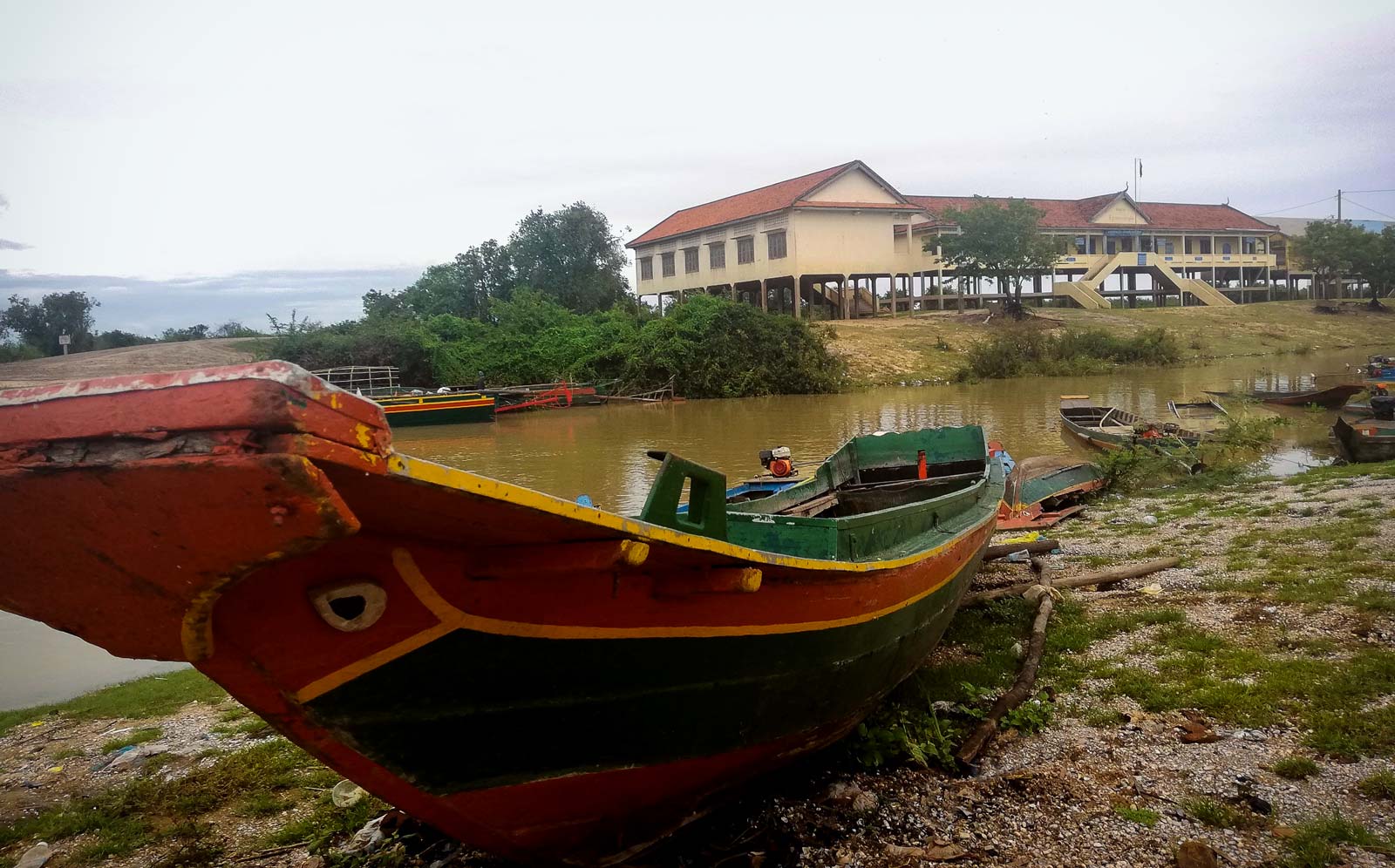
The Tonle Sap, also known as the Great Lake, is unlike any other lake in the world. Known for being the world’s largest inland fishery, it has in the past accounted for a quarter of the global freshwater catch. But what makes it truly one of a kind is not its size, but the river of the same name that feeds it – it’s the only river in the world that changes direction twice a year.
During the monsoon season, which typically begins in May, vast amounts of water originating in the Tibetan mountains and fed by other tributaries in China and Laos flow down through the Mekong system, emptying into the sea at the Mekong Delta in Vietnam.
Once the Mekong reaches levels higher than that in the Tonle Sap river, the waters spill back upstream, reversing the flow of the river so that it returns north to refill the Tonle Sap lake. The Mekong river is responsible for almost two thirds of the water that flows into the freshwater lake.
Seventy times the amount of water that sits stagnant in the lake during the dry season is sent up the riverbed, drenching the floodplains and causing the lake to swell to five times its earlier size. With the influx of water comes fish, fish eggs, sediment and nutrients enough to feed the abundant ecosystem.
But this year, the water is running late – around one to two months late, depending on your year of comparison. In a statement to Southeast Asia Globe, the Mekong River Commission claimed that this year the reversal started in early July. It normally reverses at the end of May, reaching maximum flow by late August.
Looking at the Tonle Sap from above, it would be easy to assume that the river hadn’t reversed at all, since the water levels have risen so little since July. The water is coming in lazily, as if it doesn’t know that people’s livelihoods depend on its arrival.
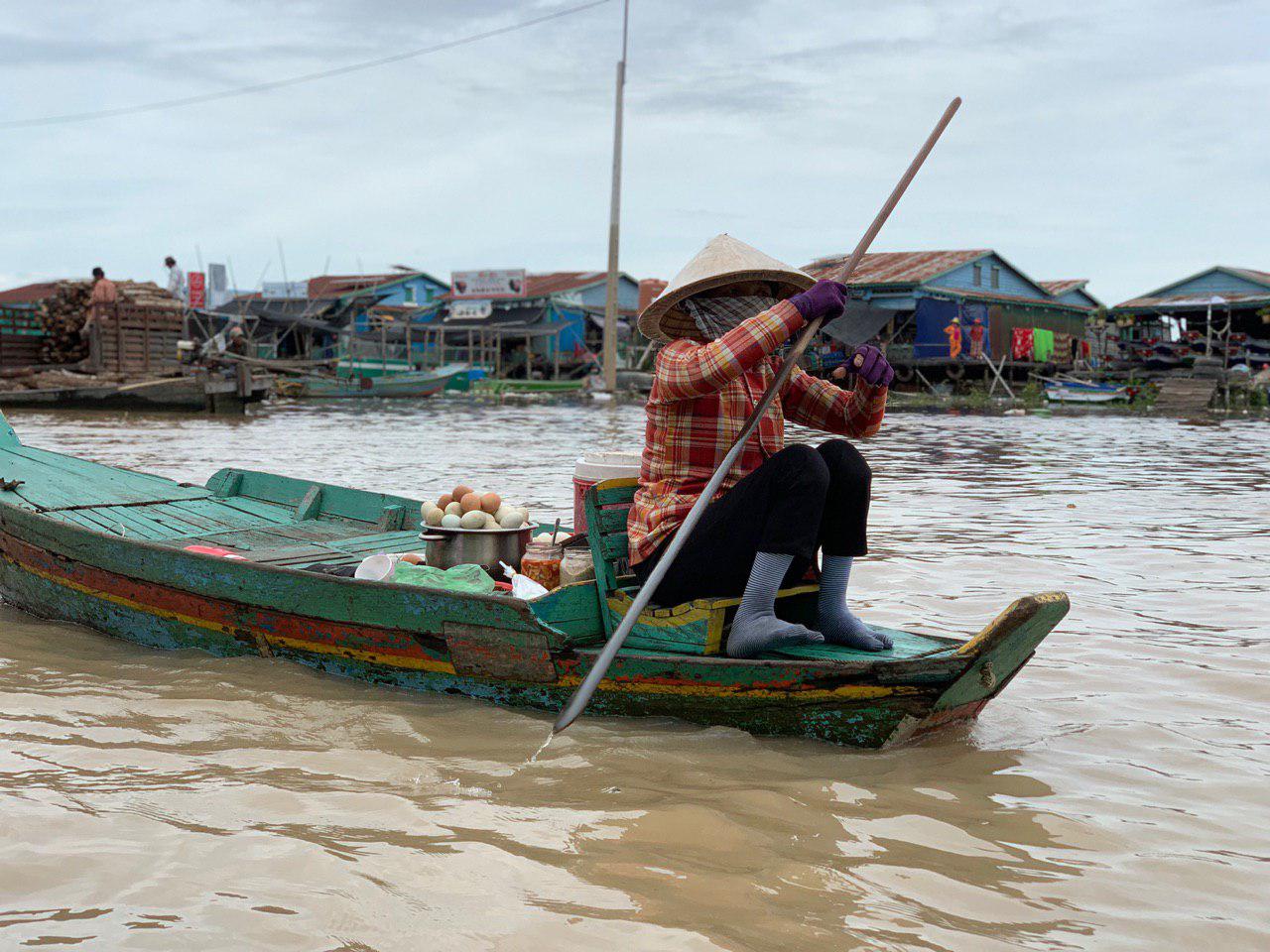
Cambodia is a nation built upon fish and rice, in that order. Fish usually make up 70% of Cambodian people’s protein intake, and almost a fifth of their entire diet. More broadly, fisheries account for 18% of Cambodia’s GDP and contribute more to the country’s economy than rice production.
But a stunted river flow – or a failure to change course altogether – could have tremendous effects on the people who look to the lake to feed their families.
Few studies have been able to tackle the fishermen’s claims that fish, nearly all fish, are declining in numbers in both the Mekong and Tonle Sap. An FAO (Food and Agricultural Organisation of the UN) study from 2011 reported major declines of the larger later-in-life spawning species, claiming that catches in the Mekong are now dominated by smaller rapidly reproducing species.
A more recent study by a group of academics found the Mekong giant catfish and the giant salmon carp have been almost eliminated, in part, by overfishing. With unprecedented low levels of water this year, no studies have yet tallied up the damage.
And the dams being built on the Mekong are making the situation worse. Researched published in 2013 by the Inland Fisheries Research and Development Institute in conjunction with MAAF predicts that even without the construction of mainstream dams fish consumption will be reduced by 30% by 2030. With the dams, this supply would reduce by up to an additional 34%. More dams mean less fish suppers.
The development of the Chinese-backed Sambor dam on the Cambodian Mekong, is alone predicted to reduce yields of fish and other aquatic animals by 16-31% – or 98,000-182,000 tonnes. A report commissioned by the government in Phnom Penh claimed that Cambodia’s biggest dam could “literally kill” the Mekong river. The report was kept secret since it was submitted in 2017, only to be leaked in May last year.
Add to this a population boom, and this prospect holds very serious implications for the health of the Kingdom. Concerns about malnutrition among children and pregnant women in Cambodia are frequently raised, with statistics published in December 2018 showing that almost one in three children are already malnourished.
Staring down at the dry dirt ringing the Tonle Sap, the toll that this year’s dry season has taken on the land is shocking to see. But what made this year so much worse than times gone by?
The blame game
“You can call and ask him, but I’m not sure if you tell him you are a journalist maybe he will not meet you. So maybe you can say you are from an NGO.”
Eng Chea San, director of the Fisheries Administration, did not in fact seem interested in talking. On hearing that the caller was a journalist, he hung up the phone.
That advice – given, tongue-in-cheek, to a journalist who had been passed from official to official – came from Dr Kao Sochivi, former deputy director general at the Fisheries Administration and now secretary general at the Ministry for Agriculture, Forestry and Fisheries (MAAF).
Asked about the causes for this year’s drought, Sochivi explained that a combination of climate change and dams upstream in China and Laos were to blame. Asked which was a greater factor, she said it was hard to tell. “We can say it is a combination, we cannot say which is the most,” she said.
“As you are already aware, climate change does not affect only Cambodia, it is a global issue,” she said. “We cannot protect [the Tonle Sap] from climate change.”
Yet Brian Eyler, Stimson Center Southeast Asia programme director and author of Last Days of the Mighty Mekong, claimed that climate collapse was just one piece of the puzzle.
“Climate change impacts such as the shortened monsoon season weren’t anticipated to set in as early as 2019,” he said.
“I will be worried sick for the fishermen in my commune if the water doesn’t fill up next year. And if next year it’s still the same, it’ll get even worse”
Chnok Tru community leader Phat Phalla
For Eyler, there are two clear causes for the Tonle Sap drought: hydroelectric dams on the Mekong, and this year’s El Nino weather pattern. Originating in the Pacific Ocean, this irregular weather pattern takes warm air and rain eastwards towards South America, leaving Asia gripped by drought. How it interacts with rising global temperatures is yet to be fully understood.
“What’s interesting is that this El Nino weather pattern, it’s easy to see when they’re coming, just using kind of standard weather prediction data, you can predict the impacts of this weather pattern,” Eyler said.
With less rain falling, he said, upstream dams could be used to release water that would alleviate the drought conditions brought about by the El Nino weather pattern.
But the problem, Eyler explained, was that “dam operators prioritise producing hydro power over reducing drought”. Despite the dry spell, he said, these operators did not release any more water this summer than in past years.
“Instead of releasing water, they held back water,” he said.
The cumulative effect of around 60 other dams on the Mekong tributaries in Laos, all acting in the same way, have severely exacerbated the drought conditions.
The Mekong River Commission reported in early August that the outflow of water from the Jinghong hydropower station in China’s Yunnan province would decrease by about 25-45% over five days, citing grid maintenance.
The fact that the dam operators chose to hold back water in this way isn’t surprising – after all, it follows the same pattern as last year. The difference is that last year there was enough rain. While China and Laos are holding back water to create power, the fact that this is destroying ecosystems and livelihoods downstream is a lesser concern.
As well as holding back the water necessary to both cause the Tonle Sap to back up into the lake and begin to fill, the dams disrupt fish migration and the flow of sediment downstream.
Natural resource governance expert and graduate of EarthRights International’s Mekong School Ham Oudom said that this sediment was a natural fertiliser for the crops that are grown along the riverbanks and floodplains.
“Without [the sediment], the plants don’t grow well,” he said.
Ten years after its construction, China’s Manwan dam is holding back more than a third of the sediment that should flow from the Lancang Basin to the Lower Mekong.
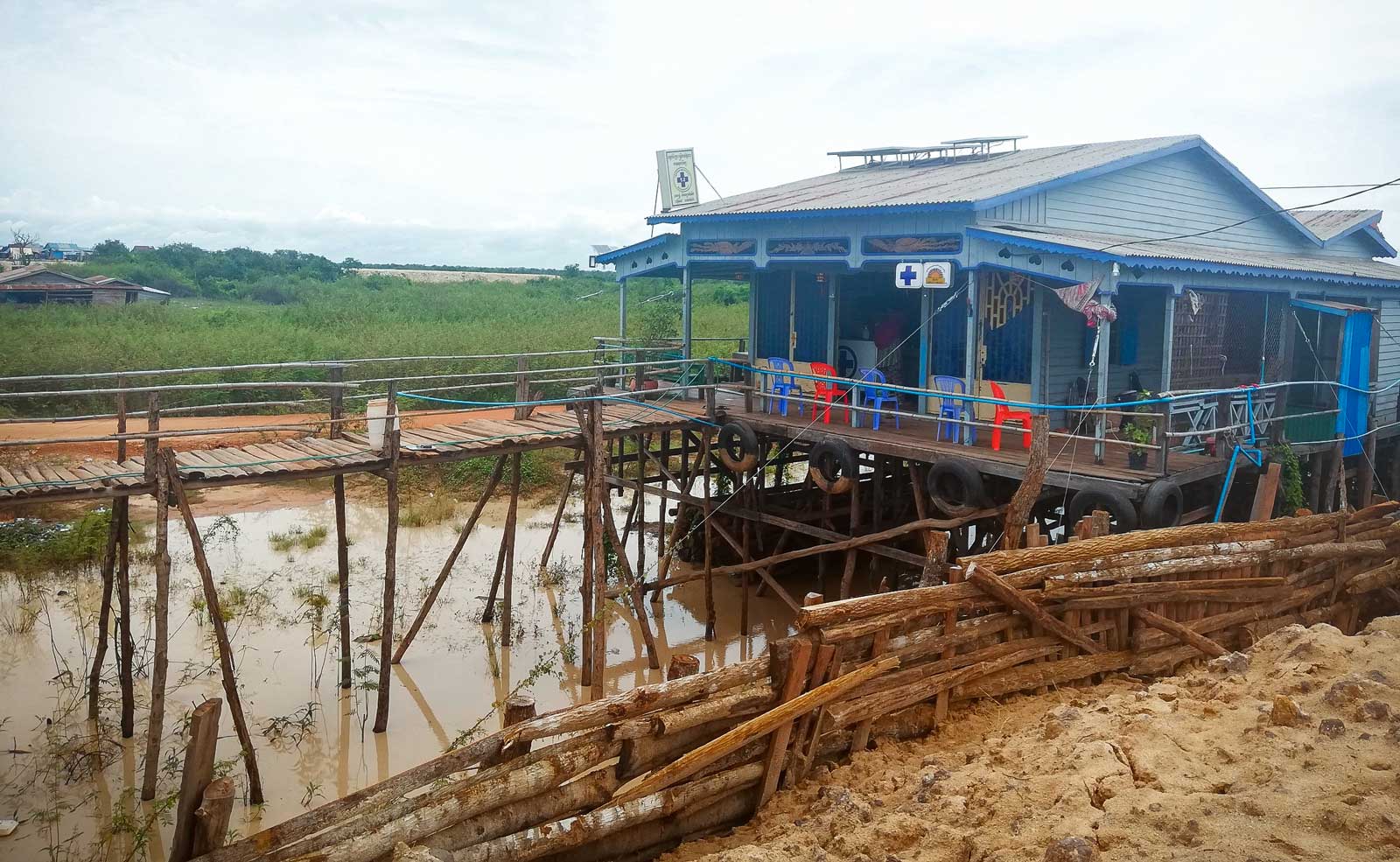
“The water comes alone without the sediment,” Oudom explained. “Even if they open the gates, the sediment cannot come.”
The source of contention is to what extent the drought can be pinned on hydroelectric dams holding back water upstream in China, Laos, and Cambodia itself, or on the global threat of climate collapse. The latter is a terrifying looming global catastrophe, but one that governments can hardly be blamed for. The former, well, that’s up for debate.
“[The government] keeps blaming the natural disaster,” said Oudom. “We do not deny the fact that the globe is changing, and global warming issue of climate change.
“But water that is dammed makes it even worse… and I think countries do not want to expose that fact.”
Not everyone needs an answer. As they wait for the Great Lake to swell, the people who live in the floating villages are more concerned with adapting to these gigantic changes than figuring out the cause.
Out of options
With no fish left to fish, what’s a fishermen to do?
Bot Hor has tried to find many ways to feed his family, though all but one are failing. Also moored in Chnok Tru, his house floats just a few yards away from his neighbour. During the dry season, Hor grows vegetables on a stretch of floodplain to prop up his income from fishing.
“My farm wasn’t flooded, it was a bad drought,” he said. “Even though I tried extracting the water from the river to cover the cracked and dry soil, it didn’t get any better.”
“The pumpkin crop was small,” he sighed, a cigarette clutched between his fingers. By his side, his 86-year-old mother chewed betel nut in silence. Every ten minutes or so, she lifted up a floorboard to spit into the water below.
Once the dry season shifts into rainy season, Hor usually takes a boat out onto the lake to catch shrimp. But this year, with the water nearly two months late, the shrimp cages are still stacked along the side of the house.
“In order to fish for shrimp, we need more water,” he said.
Instead of “waiting and doing nothing”, as he put it, his family buys and sells steamed corn, earning them about $2.5 per day.
From a government perspective, Hor’s family are something of a success story. For years, the government has encouraged fishermen to diversify their livelihoods. Two million Cambodians rely solely on fishing, with a further four million supplementing this livelihood with farming or other work.
By his side, his 86-year-old mother chewed betel nut in silence. Every ten minutes or so, she lifted up a floorboard to spit into the water below.
Part of the government strategy is to allocate land for people to move to from floating villages, having ordered some 115 Vietnamese and Khmer-Muslim families in Kampong Chhnang province to move by the end of 2018. Officials claim that electricity, infrastructure and better hygiene are necessary for development, and that settlements pollute the water through open defecation and rubbish dumping. Indeed, it is no easy task to keep track of a community whose location changes with the rise and fall of the river – much less provide them with basic social services.
Not everyone is buying it. Oudom believes the Cambodian and Chinese governments justify dam-building by citing how they can prevent flooding around the Great Lake. But, as he explained, “people call it a flood, but it is meant to flood.”
“They say this flood has been a barrier for livelihood of the people – each time the flood comes people find it hard to make their living,” he said. “This kind of assumption is very political.”
For people who look to the lake for their livelihood, he said, flooding is a fact of everyday existence.
“Floating communities are expanded during flood season, and people might have problem with sanitation,” Oudom added. “But if you ask them they will say flooding is important still.”
Bot Hor has already been allocated a plot of land by the local authorities – though, ironically, the low water level has prevented him from towing the house to the right spot. He said that his family’s life would be easier on dry land.
All dried up
“I will be worried sick for the fishermen in my commune if the water doesn’t fill up next year,” said Phat Phalla, a community leader whose role is to share information with inhabitants of Chnok Tru.
“This year it’s difficult enough when the water is this low,” she said. “And if next year it’s still the same, it’ll get even worse.”
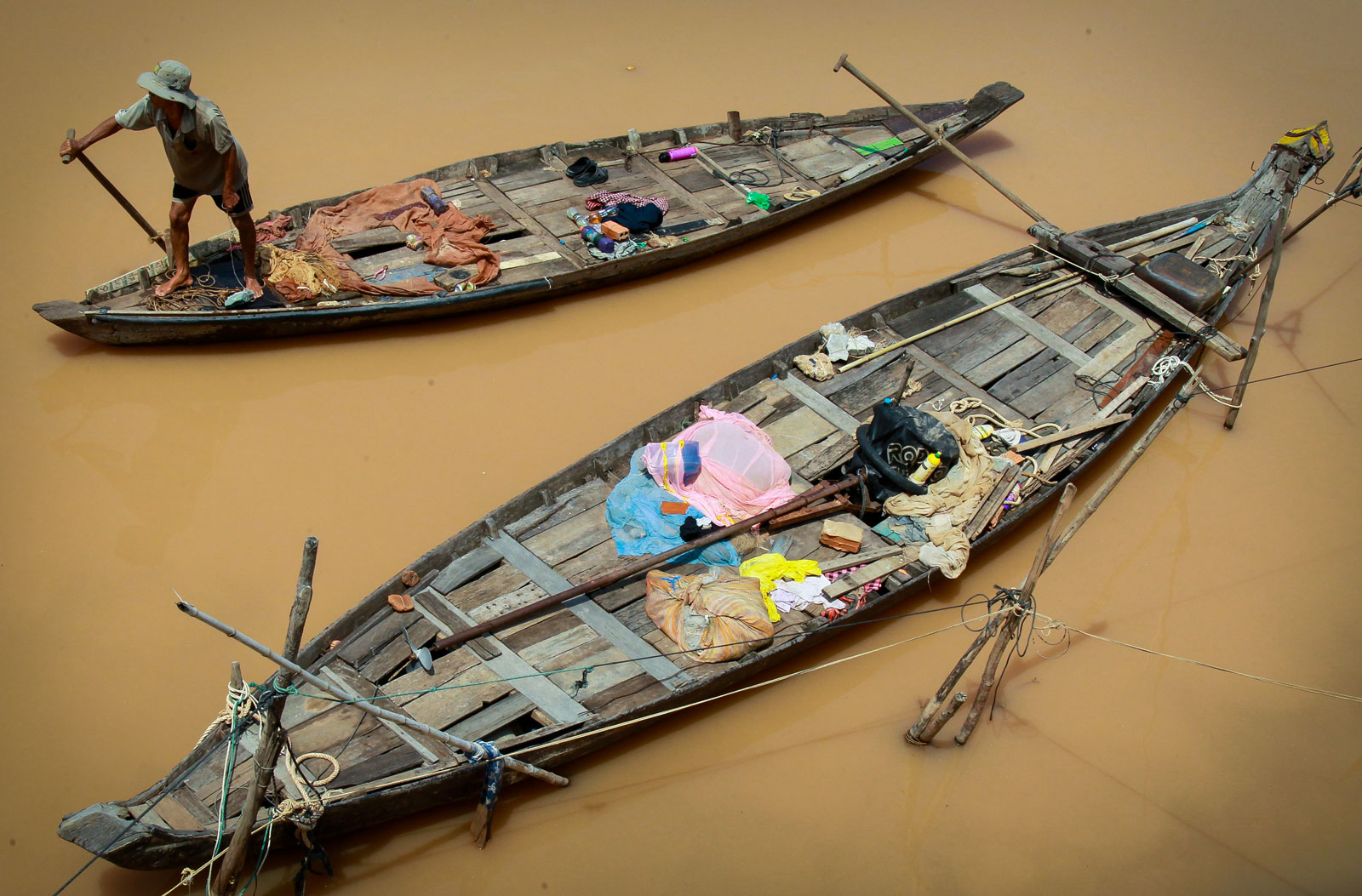
Om Savath, director of the Fisheries Action Coalition Team (FACT), is more fatalistic.
“In the future, I think that the Tonle Sap will definitely sadly be lower and lower,” he said.
The solution, he said, is to use alternative energy to hydropower dams. But with incessant damming of the Mekong with little communication with – or consideration for – those downstream, it is hard not to see a crisis on the horizon. A crisis characterised by drought, paltry fish catches and wilting crops – effects that are already driving fisher families into poverty.
At the FACT headquarters, decorated with fading posters of ‘Freshwater fishes in the Kingdom of Cambodia’ a nervous laugh slips through Savath’s teeth.
“If all those dam projects will be complete, maybe the Tonle Sap will die,” he said.
